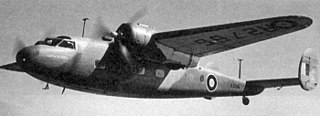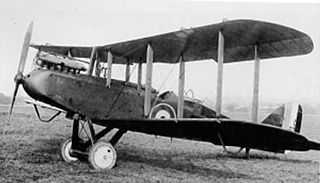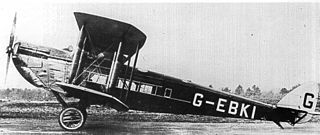| DH.9C | |
|---|---|
 | |
| Australian registered DH.9C G-AUED c.1923 | |
| Role | passenger |
| National origin | United Kingdom |
| Manufacturer | Airco |
| First flight | late 1921 |
| Number built | 19 [1] |
| Developed from | Airco DH.9 |
The Airco DH.9C was a British passenger aircraft. [1]
| DH.9C | |
|---|---|
 | |
| Australian registered DH.9C G-AUED c.1923 | |
| Role | passenger |
| National origin | United Kingdom |
| Manufacturer | Airco |
| First flight | late 1921 |
| Number built | 19 [1] |
| Developed from | Airco DH.9 |
The Airco DH.9C was a British passenger aircraft. [1]
After World War I there were many surplus Airco DH.9 light bombers, designed by Geoffrey de Havilland, available for the emerging air transport business. At first stripped DH.9s were used to carry one passenger behind the pilot in the gunner's position, but later versions, designated DH.9B, added a second passenger seat ahead of the pilot. A second seat behind the pilot was added by extending the rear cockpit in the early DH.9C. Later it had this rear position converted to hold two passengers face to face, protected by a faired dorsal canopy or cabin. Most of these later four-seat aircraft had slight sweepback to counter the rearward shift in the centre of gravity. [1] [2]
The DH.9, DH.9B, and DH.9C were dimensionally similar, with the same wingspan and height and only small variations in length depending on the powerplant. They were two-bay tractor biplanes, with fixed two-wheel main and tail-skid undercarriage. Their structures were of spruce and ash, wire-braced and fabric-covered.
The first four-seat, swept DH.9C, G-EAYT received its certificate of airworthiness on 13 January 1922. [3]
Nineteen aircraft were produced for operators, 13 in the United Kingdom, three in Australia, and three in Spain. The last in service was operated by Northern Air Lines in Barton, Greater Manchester, until 1932. [1]
Information from [4]
Data from [7]
General characteristics
Performance
Related development
The Aircraft Manufacturing Company Limited (Airco) was an early British aircraft manufacturer. Established during 1912, it grew rapidly during the First World War, referring to itself as the largest aircraft company in the world by 1918.

The de Havilland Express, also known as the de Havilland D.H.86, was a four-engined passenger aircraft manufactured by the de Havilland Aircraft Company between 1934 and 1937.

The de Havilland DH.95 Flamingo was a British twin-engined high-wing monoplane airliner first flown on 22 December 1938. During the Second World War some were used by the Royal Air Force (RAF) as a transport and general communications duties.

The de Havilland DH.80A Puss Moth is a British three-seater high-wing monoplane aeroplane designed and built by the de Havilland Aircraft Company between 1929 and 1933. It flew at a speed approaching 124 mph (200 km/h), making it one of the highest-performance private aircraft of its era.

The Vickers Vulcan was a British single-engine biplane airliner of the 1920s built by Vickers Limited at Brooklands Aerodrome, Surrey. It carried eight passengers and a pilot.

The Airco DH.4 is a British two-seat biplane day bomber of the First World War. It was designed by Geoffrey de Havilland for Airco, and was the first British two-seat light day-bomber capable of defending itself.

The de Havilland DH.84 Dragon is a successful small commercial aircraft that was designed and built by the de Havilland company.

The DH.83 Fox Moth was a successful small biplane passenger aircraft from the 1930s powered by a single de Havilland Gipsy Major I inline inverted engine, manufactured by the de Havilland Aircraft Company.

The Airco DH.9 – also known after 1920 as the de Havilland DH.9 – is a British single-engined biplane bomber that was developed and deployed during the First World War.

The Avro Andover was a 1920s British military transport aircraft built by Avro for the Royal Air Force. Four aircraft were built, in two versions. Three aircraft, the Type 561, were used as flying ambulances. The sole example of the Type 563 was used as a 12-seater transport.

The de Havilland DH.90 Dragonfly is a 1930s British twin-engined luxury touring biplane built by the de Havilland Aircraft Company at Hatfield Aerodrome.

The de Havilland DH.61 Giant Moth was a 1920s British large single-engined biplane transport built by de Havilland at Stag Lane Aerodrome, Edgware. Intended primarily for use in Australia, a number were also shipped to Canada.

The de Havilland DH.50 was a 1920s British large single-engined biplane transport built by de Havilland at Stag Lane Aerodrome, Edgware, and licence-built in Australia, Belgium, and Czechoslovakia.

The de Havilland DH.65 Hound was a 1920s British two-seat day bomber built by de Havilland at Stag Lane Aerodrome.

The de Havilland DH.66 Hercules was a British 1920s seven-passenger, trimotor airliner built by de Havilland Aircraft Company. With the Hercules, Imperial Airways took over responsibility for the airmail service from the Royal Air Force, which had been operating the obsolete Airco DH.10 Amiens.

The Airco DH.16 was a British four-seat commercial biplane of the 1910s designed by Geoffrey de Havilland, the chief designer at Airco.

The de Havilland DH.18 was a single-engined British biplane transport aircraft of the 1920s built by de Havilland.

The de Havilland DH.34 was a single engined British biplane airliner built by the de Havilland Aircraft Company in the 1920s. 12 were built, with the DH.34 serving with Imperial Airways and its predecessors for several years.

The Gloster A.S.31 Survey was a 1920s British photo-survey biplane developed by the Gloster Aircraft Company from the de Havilland DH.67 design project.

The de Havilland DH.54 Highclere was a single-engined 15-passenger biplane airliner designed to replace the DH.34. Its development ended when Imperial Airways decided to use only multi-engined types.